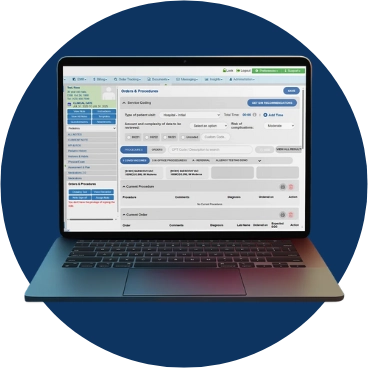Key Takeaways
- AI is already reshaping private practice—adoption success depends on choosing tools that integrate seamlessly and deliver measurable results.
- Automation reduces burnout and billing risk, giving providers more time to focus on care and documentation accuracy.
- WRS Health’s All In Intelligence represents the future of AI in medicine: intelligent workflows designed by physicians to remove the barriers that keep doctors from care.
- Learn how about how All In Intelligence means a smarter EHR
Artificial intelligence is top of mind in nearly every industry, and it’s already embedded in how healthcare organizations operate. From coding and scheduling to patient documentation, AI is quickly transforming how clinicians manage their day.
Yet as adoption accelerates, so does confusion. What actually works in private practice? How much does modernization interrupt established workflows? What AI promises are simply marketing hype?
During AI in Medical Practices: What Works and What’s Just Hype, Dr. Michael Dunn, CEO of Gateway Urgent Care and board member of the Arizona Medical Association, joined Adam Finzen, DPM, Director of Business Development at WRS Health, to help providers navigate the fast-changing AI landscape.
The session explored the smart tools showing real ROI, the pitfalls practices should avoid, and why meaningful AI for healthcare starts with workflows that work the way providers do.
Here are five insights from the discussion—and practical tips to help you apply them in your own practice.
Table of Contents
- Key Takeaways
- 1. The Healthcare AI Market Is Booming—But Not Everything Delivers Value
- 2. Private Practices Need AI to Stay Competitive
- 3. What’s Actually Working Right Now
- 4. The Hype to Avoid in AI for Healthcare
- 5. Intelligent Healthcare AI Removes Barriers for Providers
- Intentional AI Can Support Real World Care
- Related Posts
1. The Healthcare AI Market Is Booming—But Not Everything Delivers Value
AI has reached a tipping point in healthcare. According to a 2025 survey of 43 U.S. health systems, 100% reported adoption activity of an ambient AI tool for clinical documentation, yet only 53% indicated a high degree of success in using AI for documentation. As Dr. Dunn cautioned, this surge in adoption has also led to “AI inflation”—a flood of products promising transformation but offering little integration or measurable results.
Many systems are designed for enterprise hospital networks, not independent or specialty practices. Others require separate logins, high subscription costs, or disrupt established workflows. As a result, what was supposed to save time can actually slow clinicians down.
Put It Into Practice:
When evaluating an AI solution, look for measurable outcomes: time saved, revenue recovered, errors reduced. Tools should integrate into your EHR, not operate beside it. If you can’t identify a clear use case or ROI within the first demo, it may not be the right fit for your practice.
2. Private Practices Need AI to Stay Competitive
AI for private practices is quickly becoming an essential for survival. Insurance companies now use AI to pre-screen and downcode claims, shifting leverage away from providers. This means practices must match that efficiency to stay financially healthy.
Dr. Dunn noted that private practices using AI for coding assistance, claim preparation, and pre-encounter documentation see fewer denials and faster reimbursement cycles. Automating tasks like pre-visit chart prep or audit-ready documentation allows clinicians to reclaim hours each week while improving billing accuracy.
Put It Into Practice:
Identify the administrative tasks consuming the most time—documentation, coding validation, or eligibility checks—and start there. Focus AI adoption where the biggest gains in efficiency and revenue integrity are possible.
3. What’s Actually Working Right Now
Real progress with AI in medicine isn’t coming from one-size-fits-all platforms. Instead, it’s happening through specialized, task-specific tools that solve well-defined problems. Dr. Dunn highlighted five use cases delivering measurable benefits in practices:
- Ambient listening (AI Scribes): Automatically capture visit notes through secure, real-time transcription, reducing documentation time.
- Coding Assistants: Recommend codes based on documented care, improving accuracy and compliance.
- AI Search and Summaries: Quickly surface relevant details from incoming CCDAs and external records, giving providers the data they need in seconds.
- Mobile AI Apps: Extend secure access to charts, telehealth sessions, and prescribing tools.
- Patient Intake Assistants: Streamline registration by guiding patients through digital forms before appointments.
Dr. Dunn emphasized that success depends on integration and specificity. AI that works directly inside your EHR creates flow; AI that stands apart creates friction.
Put It Into Practice:
Choose AI agents that operate quietly within your existing system. The most effective solutions “fade into the background,” enhancing daily operations without requiring users to change how they work.
4. The Hype to Avoid in AI for Healthcare
Not every innovation labeled “AI” adds value. Dr. Dunn cautioned practices to look out for:
- Predictive diagnosis agents that promise to “replace” physician reasoning
- Generic tools not tuned for specialty workflows
- Add-on subscriptions that don’t connect with your EHR
- Broad claims of saving time and money with no data to back them up
These solutions often sound appealing but fail when measured against clinical realities. The goal, Dunn stressed, isn’t to replace clinicians—it’s to empower them with precision and clarity.
Put It Into Practice:
Ask vendors tough questions: How does this tool make my daily workflow faster or more accurate? Can you show results from a practice similar to mine? Transparency and specificity are your best filters against hype.
5. Intelligent Healthcare AI Removes Barriers for Providers
When done well, AI’s highest value is often hidden as it works behind the scenes to simplify care. WRS Health is All In Intelligence, building technology that doesn’t live in a dashboard but inside your daily workflow. From scheduling to billing, documentation to chart prep, intelligent agents reduce clicks, automate coding, and surface data exactly when it’s needed.
These tools are created by physicians, for physicians, designed to restore balance to modern medicine. As Dr. Dunn summarized, “AI should take away friction, not add it.0”
Put It Into Practice:
Audit your current systems and ask: Where does friction live in our day? Those are the areas where embedded AI can have the most immediate, meaningful impact.
Intentional AI Can Support Real World Care
The takeaway from Dr. Dunn’s discussion is clear: the question isn’t whether to use AI—it’s how to use it intentionally.
Healthcare’s AI evolution will favor practices that adopt technology with discernment, focusing on practical tools that support both clinicians and patients. Intelligent systems can’t replace the human side of medicine, but they can give it room to breathe.
With All In Intelligence, WRS Health is leading that shift—designing AI that simplifies, connects, and frees providers to do what they do best: deliver care.





 QUICK CHARTING
QUICK CHARTING NOTE
NOTE MEDICATION
MEDICATION PATIENT
PATIENT BILLING
BILLING RISK
RISK MARKETING
MARKETING MIPS
MIPS